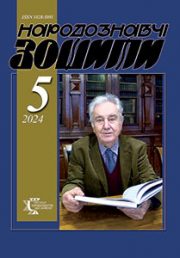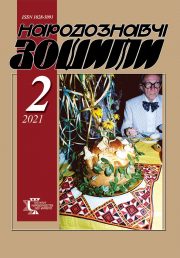The Ethnology Notebooks. 2020. № 1 (151), 155—164
UDK784.9:784.4(477):78.087.68
DOI https://doi.org/10.15407/nz2020.01.155
BEREZUTSKA Maryna
ORCID ID: https://orcid.org/0000-0002-5511-2195
Аsistant professor
Department of Folk Instruments
- Glinka Dnipropetrovsk Academy of Music,
10, Livarna Str., 49044, Dnipro, Ukraine,
Contacts: e-mail: bermarser@ua.fm; bermarser@gmail.com
Abstract. Academic bandura art emerged and formed due to the organic combination of traditions of kobzarhood, Ukrainian folk and academic music. The relevance of the article is due to insufficient scientific research of a capella works in the repertoire of bandura players ensembles. The choral pieces are invariably an important part of the repertoire of the Dnipropetrovsk bandura players ensemble «Charivnitsy» during all its more than 60-year-old creative path. The a capella pieces are much more prevalent in choirs, while the vocal-instrumental and instrumental compositions are much more common in modern bandura performing. At first glance bandura ensembles do not have an objective need for choral singing, so the invariable presence of a capella pieces in the repertoire of bandura ensembles needs to be explored. The object of the research is the repertoire of the Dnepropetrovsk bandurist ensemble «Charivnitsy», and the object is the a capella pieces in the repertoire of the ensemble. The purpose of the study was to analyze the choral pieces in the repertoire of the ensemble of bandura players «Charivnitsi» of M. Glinka Dnipropetrovsk Academy of Music, to find out its common features to determine its role and meaning for modern bandura art. The methodological basis of research comprises methods of system musicological art analysis based on the principles of comprehensiveness and consistency. All choral pieces in the repertoire of the bandura players ensemble «Charivnitsy» are written by Ukrainian composers, they are all the best examples of national choral music. Each work is a modern embodiment of the traditions of Ukrainian folklore. The choir’s repertoire of «Charivnitsy» reflects the deep essence of modern bandura performance — synthesis of the best achievements of Ukrainian traditional and academic musical art.
Keywords: ensemble of bandura players, choral repertoire, a capella, Ukrainian choral singing.
Received 4.01.2020
REFERENCES
Chabanenko, N. (2018). Bandura repertoire as a factor in the development of concert performances. Artistic notes, 33, 522—528 [in Ukrainian].
Morozevych, N. (2003). Bandura art as a cultural heritage of our time: author’s abstract. diss. for the sciences. degree of cand. art criticism: special. 17.00.03 Musical Art. Odesa: ODMA im. A.V. Nezhdanovoi [in Ukrainian].
Vyshnevska, S. (2014). Main features of traditional forms of chorus singing and their influence at the bandore art. Scientific notes of the Ternopil National Pedagogical University named after Volodymyr Hnatyuk. Series: Art Studies, 1, 150—157 [in Ukrainian].
Dutchak, V. (2017). The main tendencies in the modern bandura performance of Ukraine and the Ukrainian Diasporа. Actual problems of folk-instrumental performance in Ukraine: history and present (Pp. 5—13) [in Ukrainian].
Koshyts, O. (1970). About Ukrainian Song and Music. New-York: Nasha Batkivshchyna [in Ukrainian].
Hrinchenko, M. (1922). History of Ukrainian music. Kyiv: Spilka [in Ukrainian].
Filts, B. (2006). A wide spectrum of Galina Menkush’s creative work. To the 60th anniversary of the birth of a banda player. Folk creativity and ethnography, 3, 112—117 [in Ukrainian].
Kolubaiev, O. (2012). Formation of pop-song tradition of Galіchіna, in the context of multicultural interaction. Proceedings. Series: Art Studies, 2, 88—94 [in Ukrainian].
Shchuryk, B. (2011). Vocal creation of A. Kos-Anatolskyi. Youth and the market, 3 (74), 106—108 [in Ukrainian].
Dubilier, I. (2011). Choral genre in the works of the Donetsk composers (to the question of musical study of a particular regional). Bulletin of Lugansk National Taras Shevchenko University, 8 (219), 184—191 [in Ukrainian].
Kostiuk, N. (2012). Activity of regents is in area of liturgical-musical culture of Ukraine of beginning of ХХ age. Scientific notes of Ternopil National Pedagogical University. Volodymyr Hnatyuk. Series: Art Studies, 2, 121—129 [in Ukrainian].
Rudnytskyi, A. (1963). Ukrainian music: historical and critical review. Munich: Dniprova khvylia [in Ukrainian].
Lanovyk, M.B., & Lanovyk, Z.B. (2006). Ukrainian oral creative work. Kyiv: Znannia-Pres [in Ukrainian].
Konovalova, Y. (2013). Neo-folk projections of the «Author — Tradition» cultural dialogue based on choral music by Ukrainian composers of the turn of the 20th—21st centuries. Culture, art, education: problems and development prospects (Pp. 147—151) [in Russian].







